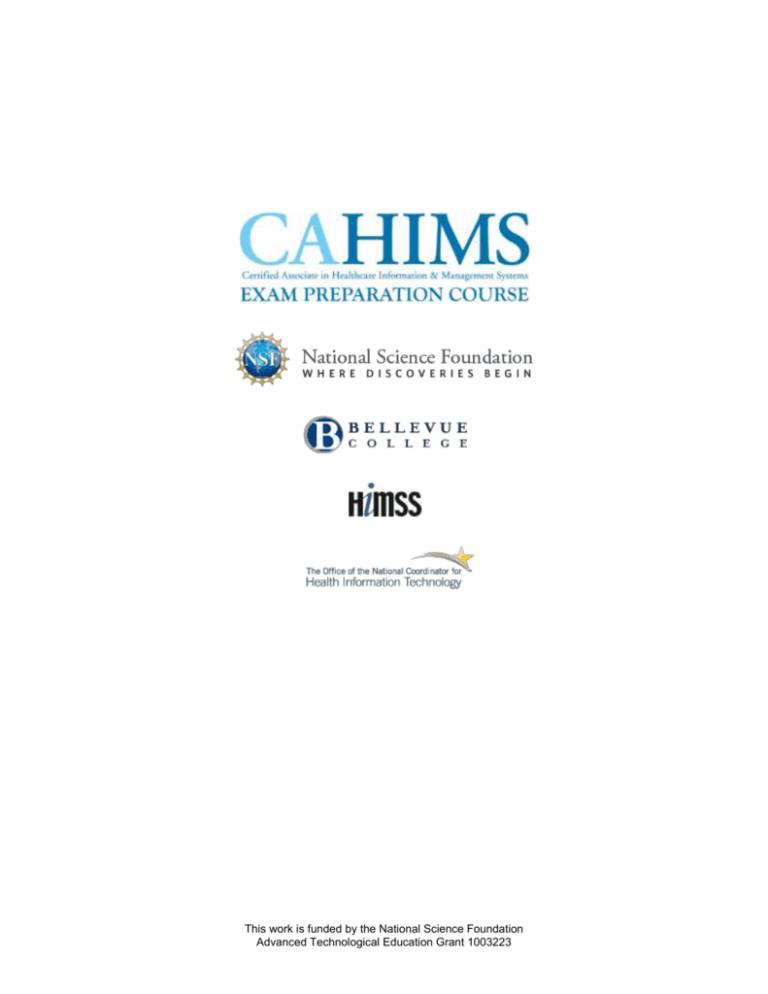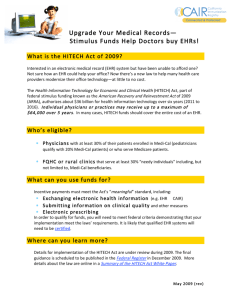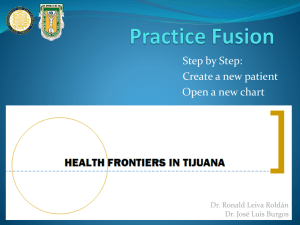4.3-Assessment-Key
advertisement

This work is funded by the National Science Foundation Advanced Technological Education Grant 1003223 The CAHIMS Exam Preparation Course and the CAHIMS exam are the result of collaboration between the Life Science Informatics Center at Bellevue College and the Healthcare Information and Management Systems Society (HIMSS). Significant content found in the CAHIMS Exam Preparation Course stems from the Office of the National Coordinator for Health Information Technology. Creation of the CAHIMS Exam Preparation Course and the CAHIMS exam was made possible through support from the National Science Foundation (NSF). Curriculum Team: Margaret Schulte, DBA Michèle Royer, PhD Nathan Savage, MLIS This work is funded by the National Science Foundation Advanced Technological Education Grant 1003223 Section 4 - HIMS Selection and Acquisition Lesson 4.3 - Interoperability Standards and Certification Assessment Questions Answer Key Lecture 1 1. Which of the following is an example of “competent human intervention” as described in the 1989 FDA policy? a. A nurse stopping a patient from taking the wrong drug *b. A physician deciding not to follow the advice of a clinical decision support system c. A chairperson of an FDA panel helping the panel to reach consensus on approving a piece of clinical software d. A health IT professional assuring that an electronic medical record is configured properly Answer: b. A physician deciding not to follow the advice of a clinical decision support system Lecture(s)/Slide(s): 1/9 2. Which organization was already an EHR certification organization prior to the establishment of the current ONC Authorized Testing and Certification Bodies? a. Drummond b. CDRH *c. CCHIT d. FDA Answer: c. CCHIT Lecture(s)/Slide(s): 1/17-18 3. What was one of the recommendations from the 1996 FDA workshop on regulating clinical software? *a. Software quality audits b. Competent human intervention as a guiding principle c. FDA regulation of EHRs d. Establishment of a certification process for EHRs Answer: a. Software quality audits Lecture(s)/Slide(s): 1/10 This work is funded by the National Science Foundation Advanced Technological Education Grant 1003223 Page 1 4. HITECH mandates certification of EHRs to assure that a. unsafe EHRs are not permitted. *b. EHRs include functionality for meaningful use. c. good manufacturing practices are followed by EHR vendors. d. EHRs are implemented properly. Answer: b. EHRs include functionality for meaningful use. Lecture(s)/Slide(s):1/22 5. FDA regulation of EHRs is UNLIKELY to reduce errors due to a. faulty hardware. b. faulty software. c. design flaws. *d. implementation flaws. Answer: d. implementation flaws Lecture(s)/Slide(s): 1/8, 27 6. Which of the following explains why FDA or CDRH pre-market and post-market reviews are difficult to perform on EHR software programs? a. The standard for “meaningful use” continues to change. *b. Problems caused by related sources and configuration designs are not easily tested. c. Congressional debates concerning jurisdiction delays the reviewing process. d. Testing the software does not ensure proper use of the software. Answer: b. Problems caused by related sources and configuration designs are not easily tested. Lecture(s)/Slide(s): 1/7, 8 7. Which of the following publications served as a catalyst for valuing HIT in relation to patient safety? a. Ross Koppel’s study in JAMA b. Dual review reports in the Annals of Internal Medicine and JAMIA in the late 90’s *c. Institute of Medicine report, “To Err is Human” d. Leapfrog’s “Development of a Consumer Communications Toolkit” This work is funded by the National Science Foundation Advanced Technological Education Grant 1003223 Page 2 Answer: c. Institute of Medicine report, “To Err is Human” Lecture(s)/Slide(s): 1/11, 13, 15, 20 8. Which was not a reaction by the Office of the National Coordinator to the anticipated use of EHRs? a. Collaboration with NIST to develop EHR usability measures b. Overseeing the establishment of Authorized Testing and Certification Bodies c. Initiating a panel discussion by the Institute of Medicine on HIT and safety *d. Recommending stricter regulations by the FDA on EHR design and implementation Answer: d. Recommending stricter regulations by the FDA on EHR design and implementation Lecture(s)/Slide(s): 1/21-27 9. According to the lecture, which is a possible drawback to EHR regulation? *a. Decrease in innovative designs b. Increased levels of problems in contracting processes that discourage reporting flaws in EHR systems c. Decrease in the application of the “competent human intervention” principle d. Increase in healthcare costs to the consumer Answer: a. Decrease in innovative designs Lecture(s)/Slide(s): 1/27 Lecture 5 10. Which of the following is NOT a reason why Electronic Health Record (EHR) system should be certified by the Certification Commission for Health Information Technology (CCHIT)? a. Evaluate patient care through quality assurance measures b. Foster information exchange among clinicians and patients *c. To ensure adoption of the system by all clinicians in a facility d. To support clinical decision making by clinicians and patients Answer: c Slides: 3-6 This work is funded by the National Science Foundation Advanced Technological Education Grant 1003223 Page 3 11. The Certification Commission for Health Information Technology (CCHIT) can best be described as: a. A consortium of EHR vendors *b. An independent, non-profit organization c. A professional society d. A regulatory agency of the U.S. Government Answer: b Slides: 3-6 12. Identify 1-2 characteristics the Certification Commission for Health Information Technology (CCHIT) with respect to the following: a. b. c. d. Type of Organization (profit/nonprofit/other): Year Founded: Governing Body: How Financed: Answer: a. Type of Organization (profit/nonprofit/other): Independent, non-profit b. Year Founded: 2004 c. Governing Body: Office of the National Coordinator for Health Information Technology d. How Financed: Industry Partners Slides: 3-6 13. Which of the following is a good example of meeting the functionality criterion, as given by the Certification Commission for Health Information Technology (CCHIT). a. An EHR that requires authorized access. *b. An EHR has a Computerized Provider Order Entry (COPE) c. An EHR uses HL Seven standards d. All of the above are good examples of meeting the “functionality criterion”. Answer: b Slide: 7 14. Provide 1 example of an EHR system that would meet the Certification Commission for Health Information Technology (CCHIT) criteria on the following CCHIT criterion This work is funded by the National Science Foundation Advanced Technological Education Grant 1003223 Page 4 a. Functionality: b. Security: c. Interoperability: Answer: a. Functionality: An EHR having a Computerized Provider Order Entry (COPE) b. Security: An EHR requires authorized access for users c. Interoperability: An EHR uses HL Seven standards Slide: 7 15. Which of the following is NOT a criterion used by the Certification Commission for Health Information Technology (CCHIT) for EHR systems? a. Functionality b. Interoperability *c. Return on investment d. Security Answer: c Slide: 7 16. It is important to certify that EHRs are up to certain quality standards for all of the following reasons EXCEPT for which one? a. Acceptance of records by clinicians b. Health information exchange c. Impact on patient safety *d. Mandated regulations by governing bodies Answer: d Slide: 7 17. The process of Certification Commission for Health Information Technology (CCHIT) includes all of the following EXCEPT which one? a. Providing system vendors with certification handbooks b. Providing system vendors with test scripts *c. Providing system vendors with example EHRs d. None of the above Answer: c Slide: 7 This work is funded by the National Science Foundation Advanced Technological Education Grant 1003223 Page 5 18. Under the American Recovery and Reinvestment Act (ARRA) of 2009, hospitals and health care professionals are required to become ‘meaningful users’ of certified EHR technology in order to do which of the following? a. Avoid financial penalties b. Practice medicine c. Receive incentive payments *d. A and C only e. A and B only Answer: d Slides: 8-10 19. Which of the following is an example of ‘meaningful use’ of EHRs? a. Keeping track of patient appointments using an EHR system b. Keeping track of patient demographic information using an EHR system c. Keeping track of practitioner work schedules using an EHR system *d. Keeping track of medications administered to a patient using an EHR system. Answer: d Slides: 8-10 20. Which of the following is an example of Stage 2 for implementing ‘meaningful use’ criteria of ARRA? a. Advanced decision-support and population health b. Submission of 80% of provider orders electronically *c. Structured data exchange and continuous quality improvement d. Use of EHR data to track conditions and coordinate care Answer: c Slides: 12-13 21. Which of the following is an example of Stage 3 criteria for ‘meaningful use’? *a. Advanced decision-support and population health b. Submission of 80% of provider orders electronically c. Structured data exchange and continuous quality improvement d. Use of EHR data to track conditions and coordinate care Answer: a This work is funded by the National Science Foundation Advanced Technological Education Grant 1003223 Page 6 Slides: 12-13 22. Which of the following is NOT a National Patient Safety Goal? a. Accurately reconcile medications b. Identify patients correctly c. Improve the safety of using medications *d. Improve tracking of public health data Answer: d Slides: 16-17 23. The role of the Food and Drug Administration (FDA) in overseeing patient safety problems include all the following EXCEPT for which of the following? a. Collaborate about certification criteria b. Focus on areas of EHR implementation that have safety risks c. Monitor patient safety problems *d. Verify that a healthcare organization is using an EHR correctly Answer: d Slides: 16-17 24. Which of the following is a benefit of Joint Commission Accreditation? a. To achieve the National Patient Safety Goals b. To be eligible for Medicare reimbursement c. To verify correct use of EHRs in providing patient care *d. All of the above Answer: d Slides: 16-17 This work is funded by the National Science Foundation Advanced Technological Education Grant 1003223 Page 7 Lecture 4 25. Which of the following is an example of a component to consider when developing information architecture? a. Printers b. Databases c. Business process d. b & c *e. All of the above Answer: e Lecture/Slides: 1-5 26. Select the appropriate sequence for developing an enterprise architecture plan: a. Information architecture, business process, technology architecture b. Business process, technology architecture, information architecture c. Technology architecture, information technology, business process *d. Business process, information architecture, technology architecture Answer: d Lecture/Slides: 1-5 27. Which of the following is an example of a component to consider when developing technology architecture? a. Applications b. Databases *c. Infrastructure d. Integration Answer: c Lecture/Slides: 1-5 This work is funded by the National Science Foundation Advanced Technological Education Grant 1003223 Page 8 28. The purpose of which of the following is to provide uniformity to the availability of different types of systems and communication methods in public health informatics? *a. Data Standards b. Architecture c. Data Configuration d. None of the Above Answer: a Lecture/Slide: 9 29. Data standards specific to Information include all of the following EXCEPT for which one? a. Extensible markup language b. Fiber-optics c. Networks d. Intranet *e. E-commerce Answer: e Lecture/Slides: 10-13 30. Which of the following is an example of a Clinical Data Representation? a. ICD-9-CM b. SNOMED-CT c. ICD-10-PCS d. a & c *e. All of the above Answer: e Lecture/Slides: 10-13 31. A patient is taking Digoxin for his atrial fibrillation. Which data standard would be MOST appropriate in this situation? a. Technical *b. Medication terminology c. Privacy and security d. Clinical data representation This work is funded by the National Science Foundation Advanced Technological Education Grant 1003223 Page 9 Answer: b Lecture/Slides: 10-13 32. Which of the following is a factor to consider for grammar data standards for communicating public health information? a. The order of data b. The structure of data c. The environment of the data *d. a and b e. All of the above Answer: d Lecture/Slides: 20 33. Which of the following is a component to consider when implementing context and data standards required for communication in informatics? a. Hardware b. Software c. Confidentiality requirements d. a and b *e. All of the above Answer: e Lecture/Slides: 21 34. Which of the following is an example of a public health classification system? a. ICD-9-CM b. ICD-10-CM c. ICD-0 d. a and b *e. All of the above Answer: e Lecture/Slides: 14, 24-25 This work is funded by the National Science Foundation Advanced Technological Education Grant 1003223 Page 10 35. Which of the following is the standards development organization responsible for the interchange of clinical and financial information? a. Accredited Standards Committee X12 b. American Society for Testing & Materials *c. Health Level 7 d. Institute of Electrical and Electronics Engineers Answer: c Lecture/Slides: 26-33 36. Which of the following is the organization responsible for data standards applicable to pacemakers or insulin pumps? a. Accredited Standards Committee X12 b. American Society for Testing & Materials c. Health Level 7 *d. Institute of Electrical and Electronics Engineers Answer: d Lecture/Slides: 26-33 This work is funded by the National Science Foundation Advanced Technological Education Grant 1003223 Page 11







